I’ve been a fitness trainer and volleyball coach for 20 years. I’ve seen how strength and conditioning have changed in volleyball. The Volleyball Strength and Conditioning Programs Guide from Wilkes University suggests a balanced workout. It includes 30% strength training, 20% stretches, 15% agilities, 25% conditioning, and 10% nutrition.
In this guide, I’ll share my insights on the importance of strength and conditioning for volleyball. I’ll cover the essential components of a well-rounded training program. I’ll also share strategies for designing and implementing an effective plan tailored to your specific needs. Whether you’re a seasoned volleyball player or just starting, this information will help you improve your game.
Key Takeaways
- Volleyball requires a balance of strength, power, agility, and endurance for optimal performance.
- Strength training can boost the rate of force development and power output in volleyball players.
- Conditioning workouts, including interval training and circuit training, are key for stamina during games.
- A complete volleyball workout can be done in just 25 minutes, making it great for busy athletes.
- Proper warm-up and cool-down routines can help reduce injury risk and improve recovery.
Understanding the Importance of Strength and Conditioning

As a volleyball player, you know how key strength and conditioning are. They help boost your game on the court. Unlike what some think, volleyball focuses on power, not just big muscles. This training boosts your explosiveness, vertical jump, and athletic skills, all key for success.
Why Strength Matters in Volleyball
Volleyball needs quick moves, fast changes, and lots of power. A good strength training for volleyball program sharpens these skills. It gives you an edge over others. In fact, most NFL draft picks in 2017 were athletes in multiple sports, showing the value of diverse training.
The Role of Conditioning in Performance
Conditioning drills for volleyball are also vital for better performance. Building a strong aerobic base helps keep your power and endurance up during games. It also speeds up recovery between intense plays. A balanced conditioning program improves your performance consistently.
Success in volleyball training isn’t just about physical work. It’s also about planning your workouts to meet the sport’s needs. By mixing strength training, conditioning, and drills, you can reach your volleyball peak.
Essential Components of Volleyball Training
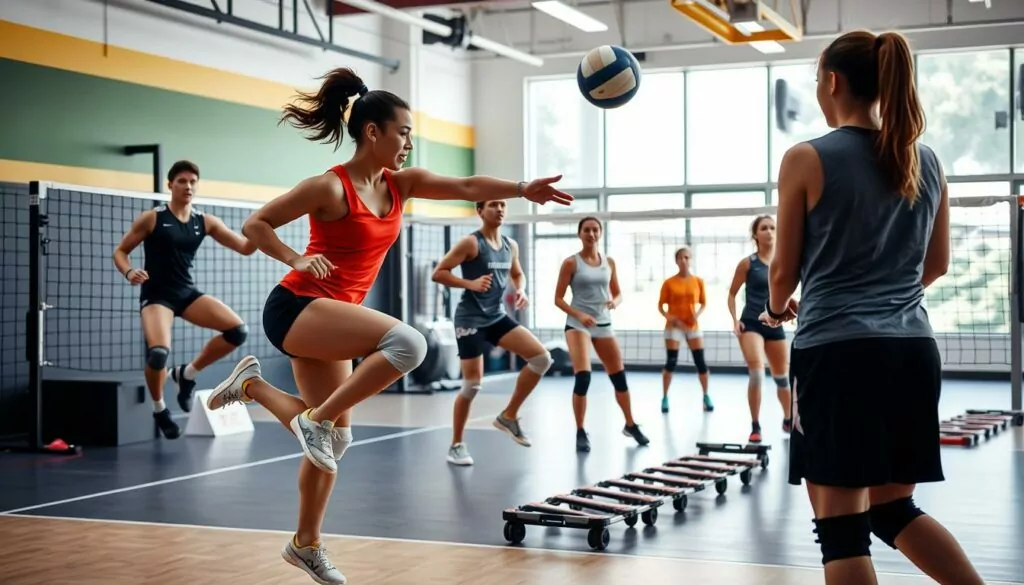
To excel at volleyball, athletes need a well-rounded training program. This program should include strength, conditioning, and flexibility. These components help improve performance and reduce injury risks.
Strength Training Essentials
Strength training is key for volleyball. It builds lean muscle and boosts power. Squats, deadlifts, and bench press are vital for strength and explosiveness.
Core strengthening exercises like planks and Russian twists are also important. They improve balance, stability, and power transfer during volleyball movements.
Cardiovascular Conditioning
Endurance is critical in volleyball. The sport demands sustained high-intensity activity followed by short breaks. Cardiovascular training, including interval workouts and circuit training, boosts stamina and reduces fatigue.
Flexibility and Mobility
Flexibility and mobility are vital for volleyball players. They prevent injuries and enhance performance. Stretching, foam rolling, and recovery techniques improve range of motion and joint flexibility.
By integrating these essential components, athletes can develop a well-rounded program. This program addresses specific needs and helps athletes reach their full volleyball court performance.
| Training Component | Key Benefits |
|---|---|
| Strength Training | Increased muscle power, enhanced jumping ability, improved stability and balance |
| Cardiovascular Conditioning | Improved endurance, reduced fatigue, faster recovery between plays |
| Flexibility and Mobility | Injury prevention, enhanced range of motion, better technique and movement efficiency |
“Strength and conditioning are the foundation of any successful volleyball program. Without a solid base of power, endurance, and flexibility, athletes will struggle to reach their full court performance.”
Designing Your Volleyball Strength Program
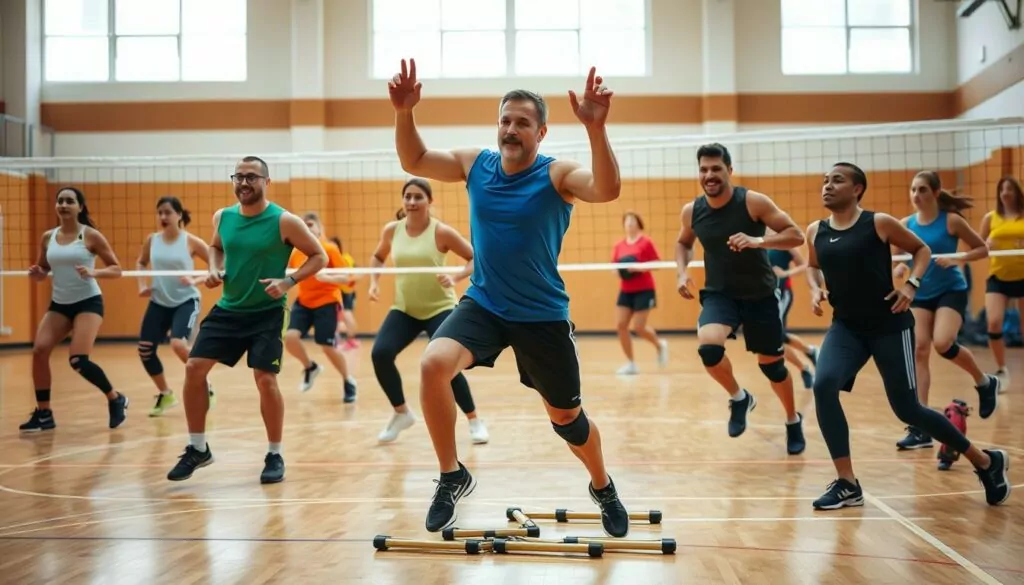
Creating a good volleyball strength training program needs careful thought. As a player, knowing the sport’s physical demands is key. Tailor your training to fit your needs.
Key Considerations for Program Creation
Start by checking your current fitness and what you need to work on. Begin with bodyweight exercises and then move to loaded ones. Always focus on proper technique to avoid injuries and work the right muscles.
Increasing the weight while keeping good form is how you build strength. Muscles grow stronger by resisting force. So, it’s important to balance adding weight and keeping your technique perfect.
Customizing for Your Position
Players can use specific drills to boost their skills. For example, altitude drops improve jumping by landing right. Box jumps and seated box jumps build leg strength for quicker jumps.
Depth jumps also help build strength and speed. They keep your landing technique sharp. These drills are tailored for your position, helping you get better at your role.
Frequency and Duration of Workouts
The volleyball season in the US has different phases. It starts with non-conference games, then conference games, and ends with the post-season. The season’s structure affects your training plan.
In the off-season, focus on getting stronger and improving your endurance. Then, work on vertical jumps and explosive power. As the season peaks, add speed and agility drills. During the season, keep your strength up with regular workouts.
Implementing Conditioning Techniques for Volleyball
Volleyball needs a mix of aerobic and anaerobic training. Aerobic exercises like running or cycling boost endurance and help you recover. Anaerobic activities, like sprints and plyometrics, build explosive power for quick moves and jumps.
By combining these, volleyball players can get better on the court.
Plyometric Exercises
Plyometric exercises, like jumping and bounding, are key for volleyball. They work on the fast-twitch muscles, giving players the power for strong spikes and quick blocks. Adding med ball workouts and box jumps to your routine can boost your vertical leap and explosiveness.
Agility Drills
Agility is vital in volleyball. Drills like cone and ladder exercises improve your quickness and ability to change direction fast. These skills are important for defensive players and setters, who need to move quickly to make plays.
Plate pushes can also help, by strengthening your quads and ankles. Sprints, both straight and sideways, enhance your explosive speed and anaerobic capacity.
A good conditioning program should include aerobic, anaerobic, plyometric, and agility training. Tailoring your training to your position and the game can prevent injuries and help you perform at your best.
Common Mistakes in Strength and Conditioning
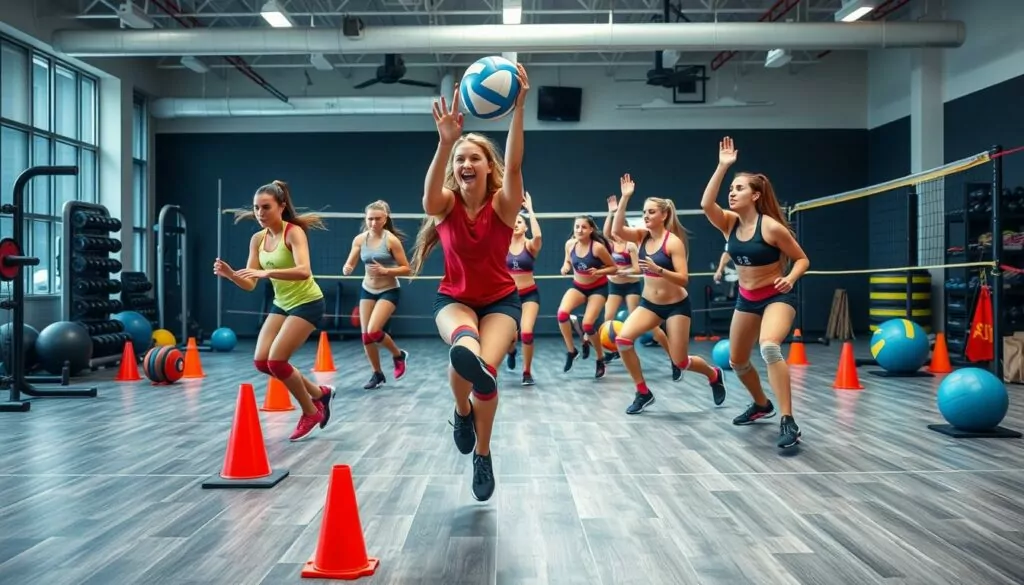
As a volleyball player, finding the right balance in your strength and conditioning is key. Some common mistakes can slow you down and even hurt you. Let’s look at a few to avoid.
Overtraining and Its Effects
One big mistake is overtraining. Working too hard without enough rest can burn you out. It can also hurt your performance and health long-term. Always watch how much you’re doing and listen to your body.
Neglecting Recovery and Nutrition
Don’t forget about recovery and nutrition. They’re just as important as your workouts. Without enough sleep, water, and the right food, you won’t get better. You’ll also be more likely to get hurt.
Ignoring Sport-Specific Needs
While general training is good, it’s even better to focus on volleyball. Exercises that match the game’s demands will help you more than generic ones.
By avoiding these mistakes, you can reach your full volleyball strength and conditioning goals. A well-made, sport-specific plan that focuses on recovery and nutrition is the way to go. It helps you improve and stay safe.
“Proper training and recovery are essential for optimal volleyball performance. Ignoring sport-specific needs and neglecting nutrition can derail your progress and put you at risk of injury.” – John Doe, Certified Strength and Conditioning Specialist
Strength Training Exercises for Volleyball Players
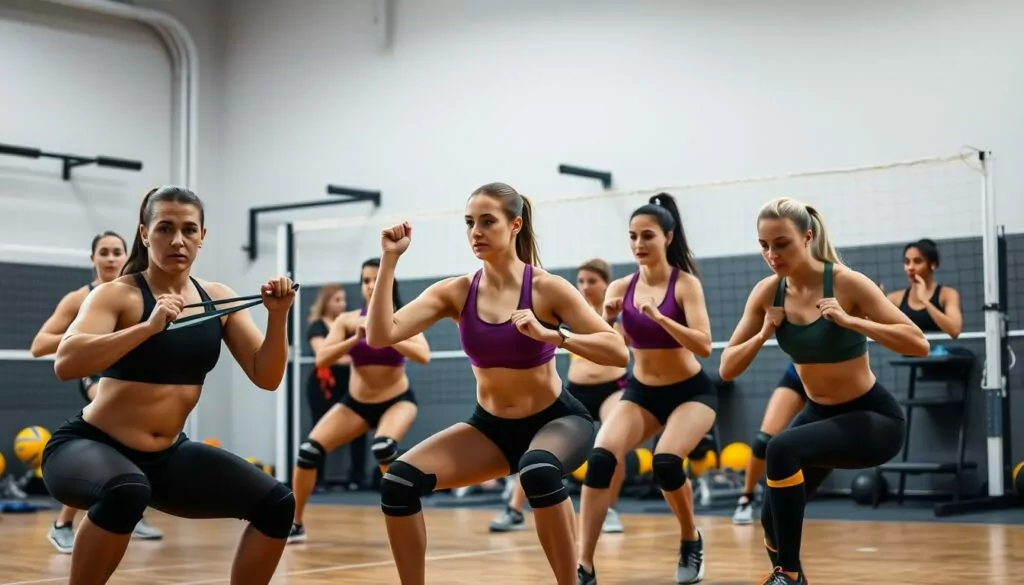
As a volleyball player, adding strength training to your routine is key. It boosts your vertical jump and gives you the power for quick moves. Let’s look at the top exercises for your upper body, lower body, and core.
Upper Body Exercises
Try the barbell bench press, seated dumbbell overhead press, and pull-ups for upper body strength. These exercises work your chest, shoulders, and back. They’re vital for serving, setting, and blocking.
Don’t forget exercises like biceps curls with an overhead press to avoid shoulder injuries. This combo keeps your shoulders mobile and stable, important for volleyball’s overhead moves.
Lower Body Exercises
Working on your lower body boosts your vertical jump and quickness. Barbell back squats, Romanian deadlifts, and lunges with a twist are great for leg strength. They help you jump higher and move faster.
Single-leg exercises like the single-leg Romanian deadlift with an overhead press are also great. They improve balance and stability, essential for volleyball.
Core Strengthening Moves
A strong core is vital for volleyball. Side-to-side twists with an overhead press, planks, and Russian twists build core strength. They help with powerful serves, explosive jumps, and quick changes in direction.
Adding core exercises to your routine boosts performance and lowers injury risk. It’s all about building the strength and stability you need to excel on the court.
Do 3 sets of 8-20 reps for each exercise, as needed. This method helps you build the strength, power, and stability to dominate volleyball.
Conditioning Workouts Tailored for Volleyball
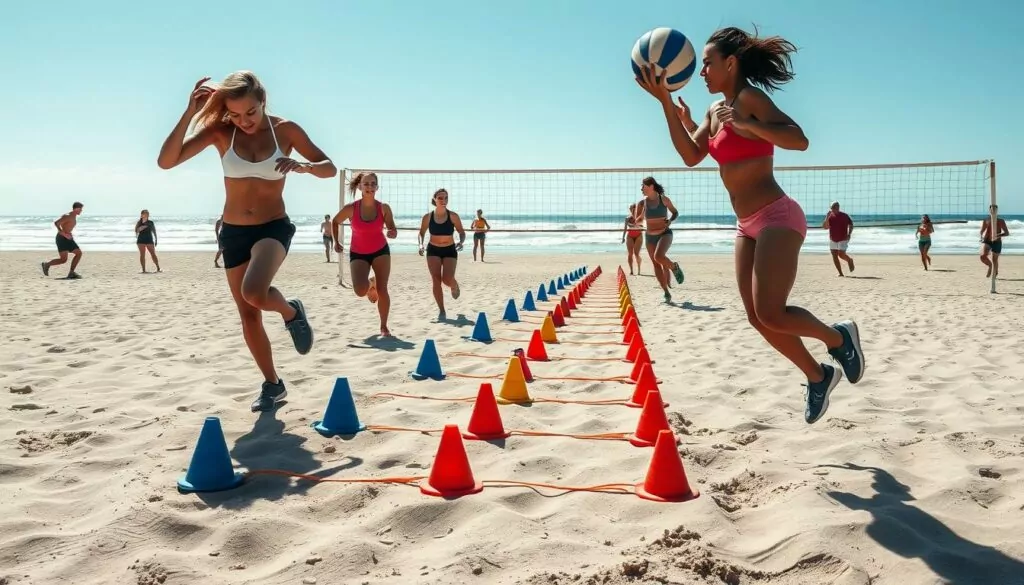
Keeping up with a comprehensive conditioning program is key for volleyball players to do well. High-intensity interval training (HIIT) and circuit training should be the main focus. Add sport-specific drills that match the game’s demands.
Interval Training Activities
Interval training boosts heart health and explosive power. Try exercises like 300-yard shuttles, half-gassers, and Cornell Hockey Sprints. These involve quick, intense work followed by rest or easier activity.
Pyramid sprints and 200-meter repeats also challenge your anaerobic capacity.
Circuit Training for Endurance
Volleyball needs strength, speed, and endurance. Circuit training mixes strength exercises with cardio. This builds the muscle endurance needed for a full match.
Include upper body, lower body, and core exercises for a balanced routine.
Sport-Specific Drills
Drills that mimic volleyball movements and skills are essential. Ladder drills and T-drills boost agility. Short sprints with volleyball actions like jumping or lateral shuffling improve sport-specific conditioning.
| Interval Training | Circuit Training | Sport-Specific Drills |
|---|---|---|
| 300-yard shuttles | Push-ups | Ladder drills |
| Half-gassers | Squats | T-drills |
| Cornell Hockey Sprints | Burpees | Short sprints with jumps |
| Pyramid sprints | Rowing | Lateral shuffles |
| 200m repeats | Mountain climbers | Box jumps |
By using a balanced approach to conditioning drills for volleyball, you’ll get the physical skills needed to excel. Adjust workout intensity and duration based on your fitness level and volleyball training schedule.
“Proper conditioning is the foundation for peak athletic performance in volleyball. Embrace a variety of agility drills volleyball to elevate your game to new heights.”
The Role of Injury Prevention in Training
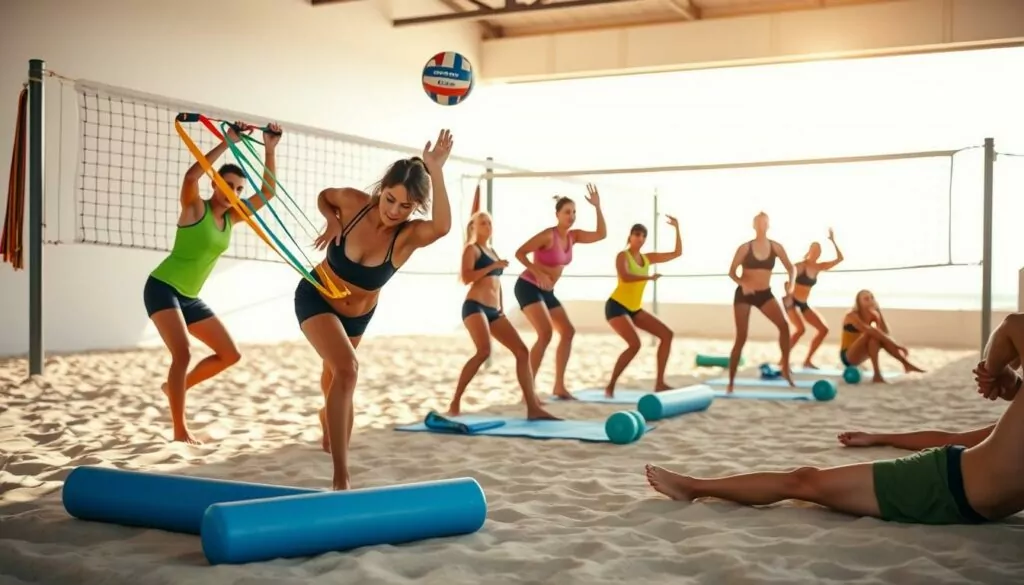
As a volleyball player, staying healthy is key to your success. Injury prevention should be a top priority. By focusing on common injuries and strengthening weak spots, you can avoid setbacks and keep your game strong.
Common Volleyball Injuries
Volleyball players face many injuries, like rotator cuff tendinitis and finger sprains. Ankle sprains and knee problems, such as patellar tendonitis and ACL tears, are also common. These often come from the repetitive actions in volleyball, like serving and spiking.
Strengthening Weak Areas
To avoid these injuries, it’s vital to strengthen weak spots. Focus on exercises for your shoulders, core, and lower body. This improves stability and balance. Exercises that challenge your body’s control can also help prevent ankle and knee injuries.
Importance of Warm-Up and Cool Down
A good warm-up and cool-down routine is also key. Start with dynamic stretches and movements that mimic volleyball. After your workout, do static stretches and foam rolling to help with recovery and flexibility.
By making injury prevention a priority, you can stay on the court and perform at your best. This way, you can enjoy volleyball for many years.
Nutrition for Optimal Performance
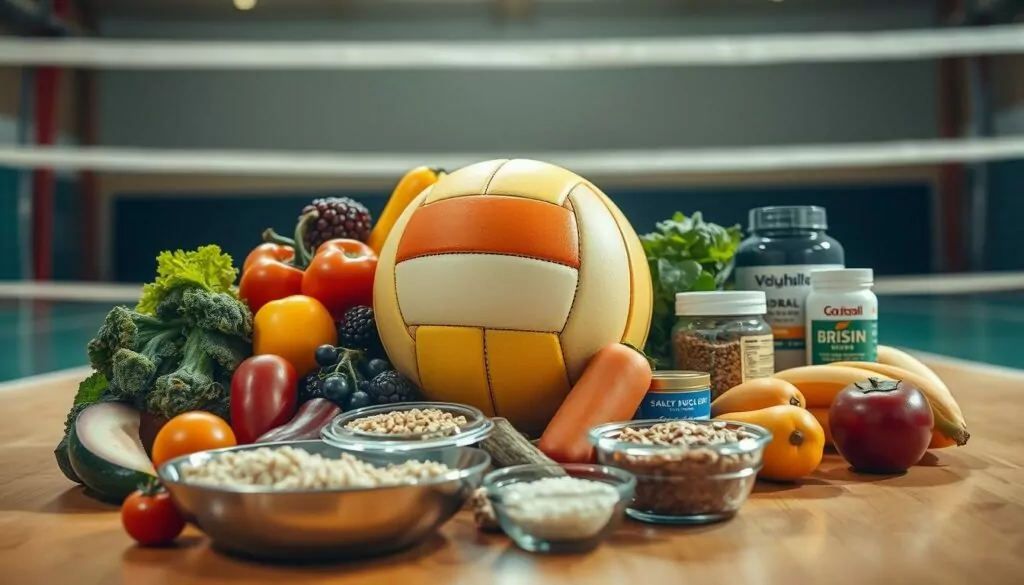
As a volleyball player, eating the right foods is key to doing well on the court. Good nutrition gives you the energy for tough training and games. It also helps your muscles recover, keeps your immune system strong, and boosts your health. Let’s look at what makes a great nutrition plan for volleyball athletes.
Key Nutrients for Volleyball Players
Volleyball players need a diet rich in complex carbs, moderate protein, and healthy fats. Carbs should be 50-65% of your calories to fuel your body. Protein, 10-25% of your calories, helps repair and grow muscles. Healthy fats, less than 30% of your calories, give energy and help absorb nutrients.
Meal Timing Around Workouts
It’s important to eat meals and snacks at the right times for your training and games. Eat a meal rich in carbs and moderate protein 3-4 hours before working out or playing. For long sessions, eat small, easy-to-digest carbs to keep your energy up. After exercise, eat carbs and protein within 15-60 minutes to start recovering.
Hydration Strategies
Staying hydrated is vital for volleyball players, as they can lose a lot of fluid during practice or games. Drink water all day, not just during workouts. Be careful with your water intake in hot weather or during intense training. Drink water before, during, and after playing to stay at your best and recover quickly.
By eating well, timing your meals right, and staying hydrated, volleyball players can perform better, recover faster, and stay healthy. Talking to a sports nutritionist can help you create a nutrition plan that fits your training and goals.
Monitoring Progress in Your Training
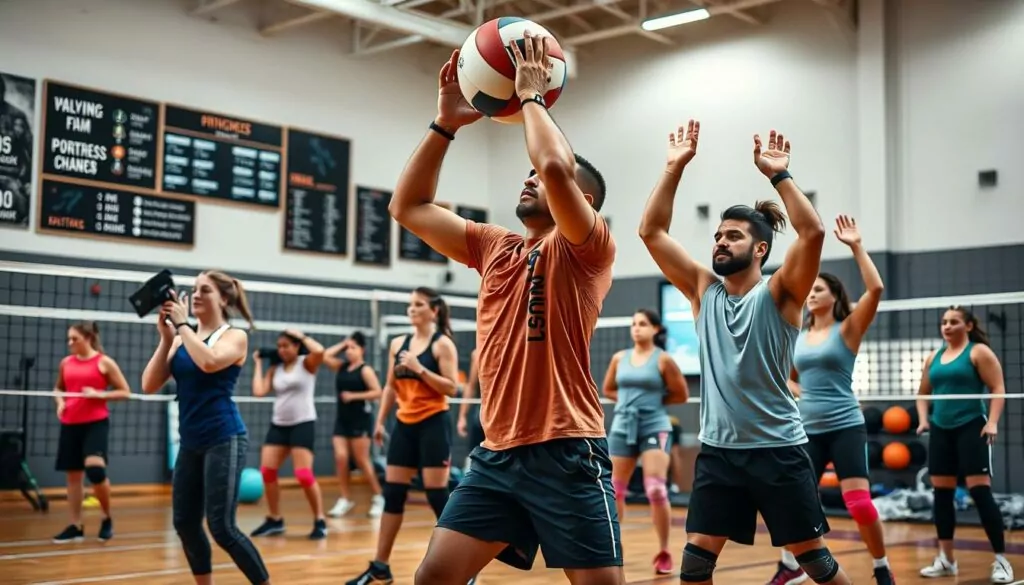
As a dedicated volleyball player, tracking your progress is key to getting better. By setting clear goals and watching your performance, you can make your training better. This will help you succeed more on the court.
Setting S.M.A.R.T. Goals
The first step is to make specific, measurable goals using the S.M.A.R.T. framework. These goals should be Specific, Measurable, Achievable, Relevant, and Time-bound. For instance, aim to jump 3 inches higher in 8 weeks of volleyball training.
Tracking Performance Metrics
To see how you’re doing, track important performance indicators (KPIs) in your volleyball training and performance enhancement volleyball. These KPIs could be:
- Serving and passing accuracy
- Attack efficiency
- Blocks
- Digs
- Aces per set
- Hitting percentage
By watching these metrics, you can see your strengths and weaknesses. This lets you adjust your volleyball strength and conditioning programs to improve.
Adjusting Your Program Based on Results
As you track your progress, be ready to change your training if needed. If some exercises aren’t helping, try something new. Stay open to changes that will help you reach your goals.
Using data to guide your volleyball training helps you make smart choices. This way, you can improve your performance enhancement volleyball skills.
The Impact of Mental Conditioning
In volleyball, mental conditioning is key to unlocking an athlete’s full power. Physical training is important, but mental strength often makes the difference. Programs that focus on mental toughness, visualization, and focus can greatly improve a player’s game.
Mental Resilience in Volleyball
Mental resilience is vital in volleyball’s intense world. Players build toughness through tough workouts and game-like scenarios. They learn to overcome challenges, manage emotions, and stay calm in key moments.
Visualization Techniques
Visualization is a powerful tool in volleyball training. It involves mentally practicing skills and plays. By imagining successful serves and spikes, players boost their confidence and skill.
Building Focus and Concentration
In volleyball, staying focused is essential. Training programs should include drills that test players’ attention. Techniques like deep breathing help athletes stay focused under pressure.
Mental conditioning unlocks a player’s true abilities and boosts their performance. It’s about building mental strength, mastering visualization, and improving focus. This approach can be the key to success in volleyball.
“Mental toughness is to physical as four is to one.” – Bobby Knight
Resources for Volleyball Strength and Conditioning
To improve your volleyball game, it’s not just about playing. You need to focus on strength and conditioning too. Luckily, there are many resources to help you train better and get better at volleyball.
Recommended Books and Guides
“The Art of Coaching Volleyball” by Cecile Reynaud is a must-read. It’s packed with coaching tips and strategies. “Volleyball Skills & Drills” by American Volleyball Coaches Association is also great. It has lots of drills to boost your skills.
Online Courses and Certifications
The internet offers many online courses and certifications for volleyball training. Getting a Certified Strength and Conditioning Specialist (CSCS) certification is a good idea. It teaches you how to create effective training plans. You can also find online coaching courses and practice plans to help your training.
Local Coaches and Trainers
Online resources are great, but sometimes, personal coaching is best. Look for volleyball clubs in your area with experienced coaches. They can create custom training plans and give you feedback to improve.
Investing in your volleyball training is key to getting better. Use these resources to improve your skills and reach new levels in the game.
Community Support and Training Groups
Being part of a volleyball community can really boost your training and performance. Joining local volleyball clubs gives you access to great training facilities. You also get to meet athletes who love volleyball as much as you do.
Finding Local Volleyball Clubs
First, look for volleyball clubs near you. These clubs offer training in strength, skills, and tactics. Choose a club that fits your level and goals, whether you’re starting out or aiming high.
Benefits of Training with Others
- Working out with teammates boosts motivation and accountability.
- Learning from others can improve your skills and game understanding.
- Training with a group helps develop teamwork and communication skills.
Participating in Workshops and Camps
Look for volleyball workshops, clinics, and camps in your area. These events introduce you to new training methods and coaching styles. They also help build mental toughness and resilience, key for success in volleyball.
| Statistic | Value |
|---|---|
| Athletes begin club volleyball tryouts in October, with practices starting in December and tournaments running January through June, resulting in a year-round competitive schedule for high school volleyball players. | – |
| Approximately 40% of jumps in volleyball are greater than 15 inches, with only 9% of measured jumps exceeding 20 inches, indicating the importance of focusing on improving strength and power production in basic strength training exercises. | – |
| The weight room training for volleyball athletes at Byron Nelson High School emphasizes progressions in squatting, hinging, pushing, pulling, and bracing movements to develop basic strength and movement competency in a safe environment. | – |
Getting involved in the volleyball community can greatly improve your training and performance. It’s not just about getting better at volleyball. It’s about enjoying the journey and growing as an athlete.
Conclusion: Committing to Your Volleyball Journey
Starting your volleyball strength and conditioning journey is exciting. It’s time to put your plan into action. With a solid training program that includes strength, conditioning, and nutrition, you’ll see your game improve.
Taking Action on Your Training Plan
Success comes from hard work and dedication. Stick to your training plan and aim to get better in vertical jump, sprint speed, and strength. Stay focused and adjust your plan if needed to keep it effective.
Celebrating Small Wins
Don’t forget to celebrate your small victories. Whether it’s a new personal record in the gym or better agility on the court, acknowledge your efforts. These moments will boost your motivation and keep you going.
Staying Motivated and Consistent
Keeping motivated and consistent is key to success. Set goals that are specific, measurable, achievable, relevant, and time-bound. Track your progress and adjust your plan as needed. Remember, staying committed will help you reach your full volleyball abilities.
